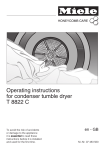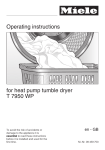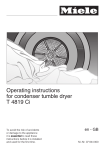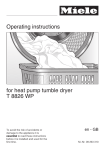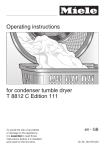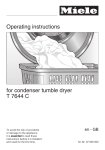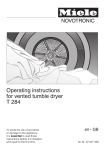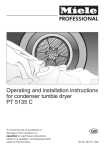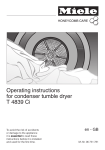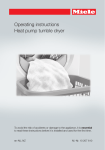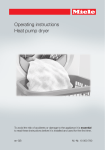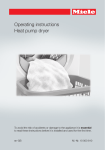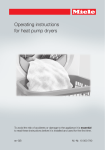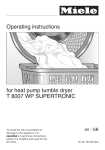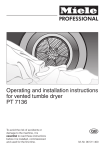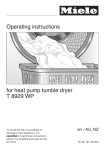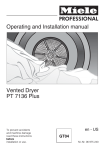Download Miele T8722 tumble dryer
Transcript
Operating instructions for vented tumble dryer T 8722 To avoid the risk of accidents or damage to the appliance it is essential to read these instructions before it is installed and used for the first time. en - GB M.-Nr. 07 636 381 Caring for the environment Disposal of the packing material The transport and protective packing has been selected from materials which are environmentally friendly for disposal and should be recycled. Ensure that any plastic wrappings, bags, etc are disposed of safely and kept out of the reach of babies and young children. Danger of suffocation. Disposal of your old appliance Electrical and electronic appliances often contain materials which, if handled or disposed of incorrectly could be potentially hazardous to human health and to the environment. They are, however, essential for the correct functioning of your appliance. Please do not therefore dispose it with your household waste. Energy saving tips To avoid unnecessarily long drying times and high consumption of energy: – Make sure that your laundry is thoroughly spun before drying. The higher the spin, the greater the savings that can be made in energy and time during drying. – Load according to the optimum amount of laundry recommended for the programme being used (see "Programme chart"). Underloading is uneconomical. Overloading gives a poorer quality of drying and may cause unnecessary creasing. – Make sure the room in which the dryer is located is well ventilated. – Make sure the fluff filter is clean before using the dryer. – Check all parts of the ventilation system on a regular basis and remove any build up of fluff etc. Please dispose of it at your local community waste recycling centre or contact your dealer for advice. Ensure that it presents no danger to children while being stored for disposal. 2 – The vent ducting should be as short, straight and smooth as possible to minimise any resistance to the air throughflow. Contents Caring for the environment . . . . . . . . . . . . . . . . . . . . . . . . . . . . . . . . . . . . . . . . . . 2 Warning and Safety instructions . . . . . . . . . . . . . . . . . . . . . . . . . . . . . . . . . . . . . 6 Operating the tumble dryer . . . . . . . . . . . . . . . . . . . . . . . . . . . . . . . . . . . . . . . . . 11 Control panel . . . . . . . . . . . . . . . . . . . . . . . . . . . . . . . . . . . . . . . . . . . . . . . . . . . . . 11 Notes on laundry care . . . . . . . . . . . . . . . . . . . . . . . . . . . . . . . . . . . . . . . . . . . . . 13 Garment care label symbols . . . . . . . . . . . . . . . . . . . . . . . . . . . . . . . . . . . . . . . . . 13 Tips on drying . . . . . . . . . . . . . . . . . . . . . . . . . . . . . . . . . . . . . . . . . . . . . . . . . . . . 13 How to dry correctly . . . . . . . . . . . . . . . . . . . . . . . . . . . . . . . . . . . . . . . . . . . . . . 14 Brief instructions . . . . . . . . . . . . . . . . . . . . . . . . . . . . . . . . . . . . . . . . . . . . . . . . . . 14 Extra options / Delay start. . . . . . . . . . . . . . . . . . . . . . . . . . . . . . . . . . . . . . . . . . 17 Extra options . . . . . . . . . . . . . . . . . . . . . . . . . . . . . . . . . . . . . . . . . . . . . . . . . . . . . 17 Low temperature. . . . . . . . . . . . . . . . . . . . . . . . . . . . . . . . . . . . . . . . . . . . . . . . 17 Buzzer. . . . . . . . . . . . . . . . . . . . . . . . . . . . . . . . . . . . . . . . . . . . . . . . . . . . . . . . 17 Delay start . . . . . . . . . . . . . . . . . . . . . . . . . . . . . . . . . . . . . . . . . . . . . . . . . . . . . . . 17 Programme chart . . . . . . . . . . . . . . . . . . . . . . . . . . . . . . . . . . . . . . . . . . . . . . . . . 18 Changing the programme sequence . . . . . . . . . . . . . . . . . . . . . . . . . . . . . . . . . 21 Once a programme has started . . . . . . . . . . . . . . . . . . . . . . . . . . . . . . . . . . . . . . 21 - changing the programme. . . . . . . . . . . . . . . . . . . . . . . . . . . . . . . . . . . . . . . . 21 - cancelling the programme and then selecting a different programme . . . . . 21 - cancelling the programme and then removing the laundry . . . . . . . . . . . . . . 21 Altering Delay start . . . . . . . . . . . . . . . . . . . . . . . . . . . . . . . . . . . . . . . . . . . . . . . . 21 Adding or removing laundry after a programme has started . . . . . . . . . . . . . . . . 21 Time remaining . . . . . . . . . . . . . . . . . . . . . . . . . . . . . . . . . . . . . . . . . . . . . . . . . . . 21 Electronic system lock . . . . . . . . . . . . . . . . . . . . . . . . . . . . . . . . . . . . . . . . . . . . 22 3 Contents Cleaning and care . . . . . . . . . . . . . . . . . . . . . . . . . . . . . . . . . . . . . . . . . . . . . . . . 23 Cleaning the fluff filter . . . . . . . . . . . . . . . . . . . . . . . . . . . . . . . . . . . . . . . . . . . . . . 23 Cleaning the grilles in the door opening . . . . . . . . . . . . . . . . . . . . . . . . . . . . . . . . 24 Cleaning the tumble dryer . . . . . . . . . . . . . . . . . . . . . . . . . . . . . . . . . . . . . . . . . . . 24 Problem solving guide . . . . . . . . . . . . . . . . . . . . . . . . . . . . . . . . . . . . . . . . . . . . 25 Check and fault messages . . . . . . . . . . . . . . . . . . . . . . . . . . . . . . . . . . . . . . . . . . 25 An unsatisfactory drying result . . . . . . . . . . . . . . . . . . . . . . . . . . . . . . . . . . . . . . . 28 Other problems . . . . . . . . . . . . . . . . . . . . . . . . . . . . . . . . . . . . . . . . . . . . . . . . . . . 29 Changing the lamp . . . . . . . . . . . . . . . . . . . . . . . . . . . . . . . . . . . . . . . . . . . . . . . . 31 After Sales service . . . . . . . . . . . . . . . . . . . . . . . . . . . . . . . . . . . . . . . . . . . . . . . . 32 Repairs. . . . . . . . . . . . . . . . . . . . . . . . . . . . . . . . . . . . . . . . . . . . . . . . . . . . . . . . . . 32 Future updates (PC) . . . . . . . . . . . . . . . . . . . . . . . . . . . . . . . . . . . . . . . . . . . . . . . 32 Appliance guarantee . . . . . . . . . . . . . . . . . . . . . . . . . . . . . . . . . . . . . . . . . . . . . . . 32 Optional accessories . . . . . . . . . . . . . . . . . . . . . . . . . . . . . . . . . . . . . . . . . . . . . . . 32 Installation and connection . . . . . . . . . . . . . . . . . . . . . . . . . . . . . . . . . . . . . . . . 33 Front view. . . . . . . . . . . . . . . . . . . . . . . . . . . . . . . . . . . . . . . . . . . . . . . . . . . . . . . . 33 Rear view . . . . . . . . . . . . . . . . . . . . . . . . . . . . . . . . . . . . . . . . . . . . . . . . . . . . . . . . 34 Installation site . . . . . . . . . . . . . . . . . . . . . . . . . . . . . . . . . . . . . . . . . . . . . . . . . . . . 34 Transporting the appliance to its installation site . . . . . . . . . . . . . . . . . . . . . . . 34 Building under a continous worktop / in a kitchen run . . . . . . . . . . . . . . . . . . . 34 Levelling the appliance. . . . . . . . . . . . . . . . . . . . . . . . . . . . . . . . . . . . . . . . . . . 35 Washer-dryer stack. . . . . . . . . . . . . . . . . . . . . . . . . . . . . . . . . . . . . . . . . . . . . . 35 Electrical connection . . . . . . . . . . . . . . . . . . . . . . . . . . . . . . . . . . . . . . . . . . . . . 36 Electrical connection U.K. . . . . . . . . . . . . . . . . . . . . . . . . . . . . . . . . . . . . . . . . . . . 36 4 Contents Installation - venting . . . . . . . . . . . . . . . . . . . . . . . . . . . . . . . . . . . . . . . . . . . . . . 37 General . . . . . . . . . . . . . . . . . . . . . . . . . . . . . . . . . . . . . . . . . . . . . . . . . . . . . . . . . 37 Calculating the effective duct length : . . . . . . . . . . . . . . . . . . . . . . . . . . . . . . . . . . 38 Installation to the rear, left or right side of the appliance . . . . . . . . . . . . . . . . . . . 39 Venting systems. . . . . . . . . . . . . . . . . . . . . . . . . . . . . . . . . . . . . . . . . . . . . . . . . . . 40 a Flexible ducting hose . . . . . . . . . . . . . . . . . . . . . . . . . . . . . . . . . . . . . . . . . . . . 40 b Plastic piping. . . . . . . . . . . . . . . . . . . . . . . . . . . . . . . . . . . . . . . . . . . . . . . . . . . 42 c Connect directly to a wall vent . . . . . . . . . . . . . . . . . . . . . . . . . . . . . . . . . . . . . 43 Washer-dryer stack . . . . . . . . . . . . . . . . . . . . . . . . . . . . . . . . . . . . . . . . . . . . . . . . 44 Consumption data . . . . . . . . . . . . . . . . . . . . . . . . . . . . . . . . . . . . . . . . . . . . . . . . 45 Technical data . . . . . . . . . . . . . . . . . . . . . . . . . . . . . . . . . . . . . . . . . . . . . . . . . . . 46 Programmable functions. . . . . . . . . . . . . . . . . . . . . . . . . . . . . . . . . . . . . . . . . . . 47 Altering the residual moisture level in the Cottons programme. . . . . . . . . . . . . . . 47 Altering the residual moisture level in the Minimum iron programme . . . . . . . . . . 48 Anti-crease . . . . . . . . . . . . . . . . . . . . . . . . . . . . . . . . . . . . . . . . . . . . . . . . . . . . . . 49 Altering the volume of the buzzer . . . . . . . . . . . . . . . . . . . . . . . . . . . . . . . . . . . . . 50 Altering the standard drying level in the Automatic plus programme . . . . . . . . . . 51 Extending the cooling down time . . . . . . . . . . . . . . . . . . . . . . . . . . . . . . . . . . . . . 52 Standby . . . . . . . . . . . . . . . . . . . . . . . . . . . . . . . . . . . . . . . . . . . . . . . . . . . . . . . . . 53 Memory function . . . . . . . . . . . . . . . . . . . . . . . . . . . . . . . . . . . . . . . . . . . . . . . . . . 55 Clean out airways indicator . . . . . . . . . . . . . . . . . . . . . . . . . . . . . . . . . . . . . . . . . . 56 Keypad tone . . . . . . . . . . . . . . . . . . . . . . . . . . . . . . . . . . . . . . . . . . . . . . . . . . . . . 57 Adjusting the dryer's electronics for very soft water . . . . . . . . . . . . . . . . . . . . . . . 58 Extending the range of the drying levels . . . . . . . . . . . . . . . . . . . . . . . . . . . . . . . . 59 5 Warning and Safety instructions ~ It must only be used as a domestic ~ It is essential to read these instructions. This tumble dryer conforms to current safety requirements. Inappropriate use can, however, lead to personal injury and damage to property. To avoid the risk of accidents and damage to the tumble dryer, please read these instructions carefully before using it for the first time. They contain important information on its safety, installation, use and maintenance. Keep these instructions in a safe place and ensure that new users are familiar with the content. Pass them on to any future owner. appliance to dry items which have been washed in a water solution and which are marked on the manufacturer's care label as being suitable for tumble drying. "Dry cleaning kits" for freshening up garments in a tumble dryer are increasingly available on the market. If using, do so at your own risk, and follow the instructions provided on the packaging. Any other usage is not supported by the manufacturer and could be dangerous. Miele cannot be held liable for damage resulting from incorrect or improper use or operation of the tumble dryer.. ~ This appliance is not intended for use by persons (including children) with reduced physical, sensory or mental capabilities, or lack of experience or knowledge, unless they are supervised whilst using it or have been shown how to use it correctly by a person responsible for their safety. Safety with children Correct application ~ This tumble dryer is not designed for ~ Keep children away from the tumble commercial use. It is intended for use in domestic households and in similar working and residential environments such as: dryer at all times. It is not a toy! To avoid the risk of injury do not allow them to play on or near it or to play with its controls. Supervise children whilst you are using it. – Shops ~ Older children may only use it if its – Offices and showrooms and by residents in establishments such as – Hostels and guest houses 6 operation has been clearly explained to them, and they are able to use it safely, recognising the dangers of incorrect use. Warning and Safety instructions Technical safety ~ Before setting up the tumble dryer, check it for any externally visible damage. Do not install or use a damaged tumble dryer. ~ Before connecting the tumble dryer, ensure that the connection data on the data plate (voltage and connected load) match the mains electricity supply. If in any doubt, consult a qualified electrician. ~ The electrical safety of this tumble dryer can only be guaranteed when continuity is complete between it and an effective earthing system which complies with current local and national safety regulations. It is most important that this basic safety requirement is present and regularly tested, and where there is any doubt the household wiring system should be inspected by a qualified electrician. Miele cannot be held liable for the consequences of an inadequate earthing system (e.g. electric shock). ~ Do not connect the tumble dryer to the mains electricity supply by an extension lead. Extension leads do not guarantee the required safety of the tumble dryer (e.g. danger of overheating). ~ Unauthorised repairs could result in unforeseen dangers for the user, for which Miele cannot accept liability. Repairs should only be undertaken by a Miele approved service technician. Ensure current is not supplied to the tumble dryer until after maintenance or repair work has been carried out. ~ Faulty components must only be replaced by genuine Miele original spare parts. Only when these parts are fitted can the safety standards of the tumble dryer be guaranteed. ~ If the connection cable is faulty it must only be replaced by a Miele approved service technician to protect the user from danger. ~ In the event of a fault or for cleaning purposes, the tumble dryer is only completely isolated from the electricity supply when: – it is switched off at the wall socket and the plug is withdrawn, or – it is switched off at the mains, or – the mains fuse is disconnected, or – the screw-out fuse is removed (in countries where this is applicable). ~ This tumble dryer may only be used in mobile installations such as ships if a risk assessment of the installation has been carried out by a suitably qualified engineer. ~ In countries where there are areas which may be subject to infestation by cockroaches or other vermin, pay particular attention to keeping the tumble dryer and its surroundings in a clean condition at all times. Any damage which may be caused by cockroaches or other vermin will not be covered by the guarantee. ~ Do not make any alterations to the tumble dryer, unless authorised to do so by Miele. 7 Warning and Safety instructions Correct use ~ To prevent the risk of fire, the following textiles must not be dried in this tumble dryer: – items which have not been washed. – items, such as workwear, which have not been thoroughly cleaned and which are still soiled with grease, oil or other deposits (such as cosmetics, lotions etc). If items have not been thoroughly cleaned there is a danger that these might ignite when heated, even after they have been removed from the dryer at the end of the programme. – items (e.g. mops and floorheads) which have been treated with inflammable cleaning agents or contain residues of acetone, alcohol, benzine, petrol, stain remover, turpentine, wax, wax remover or other chemicals. – items which have been splashed with hair lacquer, hair spray, nail varnish remover or similar substances. When washing such heavily soiled items ensure that you use sufficient detergent and select a high temperature. If in doubt, wash the items several times. ~ To prevent the risk of fire, the following must not be dried in this tumble dryer: – items which have been cleaned using chemicals (e.g. professional dry-cleaning agents). – fabrics which contain a large proportion of rubber, foam rubber or rubber-like materials. For example, products made from latex foam rubber, shower caps, waterproof textiles, rubberised articles and items of clothing and pillows with foam rubber filling. – damaged items which contain padding or fillings (e.g. pillows, jackets). When damaged, the filling can get out with the risk of it igniting in the dryer. ~ In many programmes, the heating phase is followed by a cooling down phase to ensure that the items are not too hot to handle when you remove them (this also avoids the danger of the laundry self-igniting). The programme is not finished until the cooling down phase has been completed. Ensure that you always wait until the end of the programme before removing the laundry. ~ Warning: Do not switch the tumble dryer off before the end of the drying programme. If this was done and the laundry was then removed immediately it could give off a great amount of heat. ~ Fabric conditioner and similar products must be used according to the instructions on the manufacturer's packaging. 8 Warning and Safety instructions ~ The dryer must not be used without the fluff filter in place or if the fluff filter is damaged in any way. ~ The fluff filter must be cleaned regularly. ~ The tumble dryer must not be used without vent ducting in place. ~ The tumble dryer must not be connected to a chimney or vent flue which is in use. ~ Do not install the tumble dryer in a room where there is a risk of frost occurring. At temperatures around freezing point the tumble dryer may not be able to operate properly. The ambient room temperature should be between +2°C and +35°C ~ Check all parts of the extraction system on a regular basis (e.g. wall vent, external grille, bends in the ducting etc.) and make sure they are all free of any hindrance. A build-up of fluff will prevent a free flow of air through the system. If the dryer is to be connected to an existing ducting system, this must be checked for suitability beforehand. ~ Adequate ventilation is essential to avoid the danger of asphyxia and toxic fumes where another appliance which also uses the room air (e.g. gas, oil or coal fired heater, continuous flow or other water heater) is installed in the same or an adjacent room. To ensure safe operation, and to prevent gases given off by these appliances being drawn back into the room, an underpressure of 0.04 mbar is the maximum permissible. Ventilation can be maintained by: – air inlets in the external wall which cannot be closed or blocked, or – by fitting a window contact switch which ensures that the tumble dryer can only be operated when the window is opened wide enough. If in doubt, the advice of a competent builder must be sought. ~ Always keep the area around the tumble dryer free of dust and fluff. Particles of dirt entering the dryer can lead to blockages occurring. ~ The exhaust air must not be vented into a chimney or vent flue which is in use, nor should it be connected to ducting which ventilates rooms with fireplaces. It would be dangerous if smoke or exhaust fumes were drawn back into the room. 9 Warning and Safety instructions ~ Do not let anyone sit or lean on the door, as this can cause the tumble dryer to tip up. ~ Always close the door after use. This way you will avoid the danger of: – children climbing onto or into the dryer or hiding things in it. – pets or other small animals climbing into it. ~ The tumble dryer must not be hosed down. Accessories ~ Only use genuine Miele spare parts and accessories with this appliance. If non-Miele parts are used, guarantee, performance and product liability claims may be invalidated. Miele cannot be held liable for damage caused by non-compliance with these Warning and Safety instructions. 10 Operating the tumble dryer Control panel a Low temperature button Delicate fabrics are dried at a lower temperature. b Drying level button with indicator lights to show the drying level selected. c Display See next page. d Delay start button This button is used for: - Delaying the start of a programme - Selecting the duration of the timed drying Warm air and Cool air programmes g Check lights For a description of these, see "Problem solving guide" / "After sales service". h Start/Stop button For starting or cancelling a programme. The button flashes while a programme is being selected and then lights up constantly when the programme has started. i Programme selector with indicator lights to show the programme selected. e Buzzer button An audible tone sounds at the end of the programme. j Door button Pressing this button will open the door even when the dryer is switched off at the mains. f Perfect Dry indicator For all programmes with a selectable drying level. See next page. k On/Off button jk For switching the dryer on and off. 11 Operating the tumble dryer The display shows: Perfect Dry indicator – Programme duration After a programme has started, the electronics will estimate the duration of the programme (time remaining). The Perfect Dry indicator will flash while this is happening. After a short while, the programme duration will appear in the display and the indicator will go out. The Perfect Dry indicator will light up again when the selected drying level is reached and remain on until the programme is finished. – Programme stage Drying Cooling down Finish – Check and fault messages The following are also selected via the display: – Duration of the Warm air and Cool air programmes – Delay start You can select a programme and set it to start at a later time. The programme will start automatically once the delay start time has elapsed. – Programmable functions Default settings can be altered to adapt the dryer to different requirements. See "Programmable functions" at the end of this booklet for more details. 12 Programme duration / Estimated time remaining The estimated duration (time remaining) will appear in the display. The following factors all affect the estimated time remaining: residual moisture content after spinning; type of fabric; size of load; room temperature; fluctuations in power supply. The electronics continually assess conditions in the appliance and adjust the estimated time remaining for a more accurate reading. Because of this, the time displayed can alter during the course of a programme. Programmes can also finish earlier than expected if, for example, particularly fine fabrics are being dried, the load is very small or items were partially dry beforehand. Notes on laundry care Garment care label symbols Drying q Normal/higher temperature r Reduced temperature: Select Low temperature (for delicate textiles) s Do not tumble dry Ironing I Very hot H Hot G Warm J Do not iron Tips on drying – Always observe the maximum recommended loads given in the "Programme chart". Never overload the drum. Overloading can cause unnecessary wear and tear to the laundry, give a disappointing drying result and cause more creasing. – Do not put soaking wet items into the tumble dryer. Spin fabrics for at least 30 seconds before drying. – Open jackets so that they can dry evenly. – Use the Automatic plus programme for drying mixed loads of cotton and minimum iron fabrics. – Woollens and wool blends tend to become matted and shrink if dried in a tumble dryer. They can, however, be "fluffed up" using the Woollens handcare programme. – Down-filled garments have linings which have a tendency to shrink, depending on the quality of the item. They can be partially dried using the Gentle smoothing programme. – Pure linen should only be machine dried if specified as suitable by the manufacturer on the care label, as the surface of the fabric may otherwise become rough. – Loopknit garments (e.g. T-shirts and underwear) tend to shrink depending on their quality. Do not over-dry these textiles. When purchasing these garments it is advisable to take their shrinkage properties into account. – Minimum iron fabrics tend to crease more, the larger the load. This is also the case for garments made from very fine weave fabrics, such as shirts or blouses. If in doubt, divide the garments into smaller loads. – Starched laundry can be dried in the tumble dryer. To achieve the usual finish, double the amount of starch should be used. – New dark coloured garments should be washed and dried separately from light coloured garments to avoid the danger of colours running and discolouring other garments or even plastic components in the dryer. Dark coloured fibres can also settle on light coloured garments and vice versa. 13 How to dry correctly Brief instructions C Load the tumble dryer The headings numbered (A, B, C ...) show the operating sequence and can be used as a brief guide to using your dryer. ^ Press the Door button to open the door. ^ Load the laundry loosely into the drum. A Sort the laundry To ensure an even drying result separate out the washed laundry and sort it according to: . . . the drying level required . . . the type of fibre or weave . . . size . . . the moisture content after spinning. ,Make sure that objects e.g. detergent dispensing balls have been removed from the laundry. They could melt, and cause damage to the dryer or the laundry. Do not overload the drum. See the "Programme chart" for recommended loads for each programme. Overloading can cause unnecessary wear and tear to the laundry and give a disappointing drying result. ^ Before closing the door make sure the fluff filter is correctly positioned. – Check seams and stitching to ensure that padding and linings are intact. – Fasten duvet covers and pillow cases to prevent small items from being trapped inside them. – Fasten hooks and eyes etc. – Tie fabric belts and apron strings. – Sew in or remove underwiring from bras. B Turn on the tumble dryer ^ Switch the dryer on by pressing the On/Off jk button in. The tumble dryer may be switched on after loading, saving energy as the light will not come on. 14 Check the laundry is right inside the drum so that it cannot get trapped or damaged when the door is shut. ^ Shut the door either with a gentle swing, or lean against it and push it shut. How to dry correctly D Select a programme programmes and with some the drying level is pre-set and cannot be changed. Note You can extend the range of the drying levels for some programmes (see "Programmable functions"). Woollens handcare – This programme cannot be changed. ^ Select the programme you want. The indicator for the programme selected will light up. A drying level or extra option indicator may also light up and the duration may also be displayed. Drying level programmes – Cottons, Minimum iron, Delicates, Proofing, Express, Automatic plus, Denim, Shirts, Gentle smoothing Selecting the duration of the timed drying Cool air and Warm air programmes The indicator light for the Delay start button will flash when the Cool air or Warm air programme is selected. ^ Press the Delay start button repeatedly until the required duration shows in the display. You can select the duration in stages for: – Cool air: from 20 minutes up to 1:00 hour. – Warm air: from 15 minutes up to 2:00 hours. E Select any Extra options / Delay start ^ Press the drying level button repeatedly until the indicator for the drying level you want lights up (for almost all programmes). Any of the four drying levels can be selected for the Cottons and Express programmes. A more limited range is available when using other ^ Low temperature, Buzzer and Delay start (see "Extra options/Delay start)" are selected by pressing the appropriate button. Anti-crease (see next page) is permanently switched on. N.B.: It is not possible to select Delay start when using the Warm air or Cool air programmes. 15 How to dry correctly F Start the programme The Start/Stop button will flash when a programme is being selected. The flashing indicates that a programme can be started. ^ Press the Start/Stop button. The Start/Stop button will now light up constantly. * Drying will appear in the display and the Perfect Dry indicator will flash. The indicator will go out after approx. 1 minute and the estimated programme duration will appear in the display. G Remove the laundry when the programme has finished 0 and Finish will appear in the display to indicate that the programme has finished. The buzzer (if selected) will sound at intervals. The drum will continue to rotate at intervals for up to two hours to prevent laundry creasing, if you do not wish to remove it immediately (anti-crease). There is no anti-crease phase at the end of the Woollens handcare programme. ^ Press the Door button. Note: The duration shown in the display is an estimate and can vary. ^ Open the door. Before the end of a programme ^ Remove the laundry. * The Perfect Dry indicator will light up. There is a cooling down phase at the end of the drying sequence (Cooling down will appear in the display). The programme will not finish until the cooling down phase has been completed. There is no cooling down phase at the end of the Woollens handcare programme. * Only with programmes with drying levels (exception: Gentle smoothing). Check that all items have been removed from the drum. If items are left in the dryer, they could be damaged by overdrying when the dryer is next used. If the dryer is switched on at the mains and the door is opened, the drum lighting will come on. It will go out a few minutes later to save energy. ^ Switch the dryer off by pressing the jk button. ^ After every cycle, remove the fluff from the fluff filter in the door. ^ Close the door. 16 Extra options / Delay start Extra options To begin delay start Low temperature ^ Press the Start/Stop button. Delicate and minimum iron fabrics with the r symbol on the care label (e.g. acrylic garments) are dried at a lower temperature. The programme duration is longer. On some programmes Low temperature is permanently activated and so cannot be deselected. Buzzer A buzzer sounds (at intervals for a maximum of 1 hr) to let you know the programme has finished. A continuous alarm will sound if there is a fault even if the buzzer has been switched off. Delay start You can delay the start of a programme by 30 minutes up to 24 hours. ^ Select a programme. ^ Press the Delay start button repeatedly until the required delay period shows in the display. – The Delay start indicator light will flash. – Times of up to 10^ are selected in steps of half an hour, and more than 10^ in one-hour steps. – If you keep the Delay start button pressed in, the time will continue to increase up to 24^. – The Delay start indicator will light up constantly. – Delay start times of more than 10^ will count down in hours, and of less than 10^ in minutes to the start of the programme. – The drum will turn briefly every hour to help prevent creasing. To cancel / alter delay start ^ Press the Start/Stop button to cancel delay start. ^ To alter the delay start time, press the Delay start button repeatedly until the required delay period shows in the display. ^ Press the Start/Stop button to start the altered delay start time counting down from the beginning again. To add laundry after the delay start time has started counting down While the delay start time is counting down, you can still add laundry to the drum: ^ Switch the dryer off. Opening the door without switching the dryer off will cancel delay start. ^ Open the door and add the laundry. ^ Close the door and switch the dryer back on again. 17 Programme chart Cottons Max. load 7 kg* Extra dry, Normal** Fabric type Single and multi-layered cotton fabrics such as towelling, T-shirts, underwear, flannelette bed linen. Notes – Select Extra dry for multi-layered and very thick fabrics. – Do not use Extra dry for loopknit fabrics (e.g. T-shirts, underwear, baby clothes), as they have a tendency to shrink. Low temperature Select the Low temperature option for delicate fabrics with the r symbol on the care label. Hand iron**, Machine iron Fabric type Cottons or linen fabrics, e.g.: table linen, bed linen, starched laundry. Note – To prevent laundry from drying out it should be rolled up until you are ready for ironing. Low temperature Select the Low temperature option for delicate fabrics with the r symbol on the care label. Minimum iron Max. load 3.5 kg* Normal**, Hand iron Fabric type Minimum iron items made of cotton, synthetic or blended fabrics, e.g.: dresses, trousers, skirts and table cloths. Low temperature Select the Low temperature option for delicate fabrics with the r symbol on the care label. Delicates Max. load 2.5 kg* Normal, Hand iron Fabric type Delicate items made of synthetic fibres, easy care cotton or blended fabrics, e.g. shirts, blouses, lingerie and appliquéd garments. Low temperature Low temperature cannot be deselected. * Weight of dry laundry ** Note for test institutes: Use this programme without selecting Low temperature for testing according to Standard EN 61121. 18 Programme chart Woollens handcare Max. load 2 kg* Fabric type Woollen fabrics Notes – This programme only fluffs up woollen garments. They are not dried completely by this programme. – Remove garments as soon as the programme has finished and leave to finish drying at room temperature. Low temperature Low temperature cannot be deselected. Proofing Max. load 2.5 kg* Normal Fabric type For drying microfibre fabrics, skiwear, fine, closeweave cotton garments (poplin) or tablecloths which are suitable for drying in a tumble dryer and have been treated to provide a water and dirt resistant finish. Notes – This programme includes a proofing fixing phase. – Only use proofing agents containing fluorochemical compounds which are stated by the manufacturer as being "suitable for use on membrane textiles. – Do not dry items which have been treated with proofing agents containing paraffin. Fire hazard! Express Max. load 3.5 kg* Extra dry, Normal, Hand iron, Machine iron Fabric type Fabrics which can tolerate high temperatures with the q symbol on the care label and which can be dried in the Cottons programme. Note – The programme duration is shorter. Automatic plus Max. load 5 kg* Normal, Hand iron Fabric type Mixed loads of garments suitable for the Cottons and Minimum iron programmes. Sort according to colour. Denim Max. load 3 kg* Normal, Hand iron Fabric type Denim garments, e.g. jeans, jackets, skirts, shirts. Low temperature Select the Low temperature option for delicate fabrics with the r symbol on the care label. * Weight of dry laundry 19 Programme chart Shirts Max. load 2 kg* Normal, Hand iron Fabric type Shirts and blouses. Low temperature Select the Low temperature option for delicate fabrics with the r symbol on the care label. Cool air Fabric type Max. load 7 kg* Any item which only needs airing. Warm air Max. load 7 kg* Fabric type – Voluminous and multi-layered fabrics whose layers have different drying characteristics, e.g. jackets, pillows. – For drying individual items, e.g. bath towels, swimwear, tea-towels. Note – Do not select the longest drying time to start with. Check the items as you are drying them to find the optimum time. Low temperature Select the Low temperature option for delicate fabrics with the r symbol on the care label. Note You can use the Warm air programme to help remove odours from clean cotton clothing (select a duration of between 1/2 and 1 hour). Items must be suitable for drying in a tumble dryer. Dampen the garments a little beforehand or add a fabric conditioner sheet. Odours will not be removed as effectively from any parts of the garments which are made of synthetic fibres. Gentle smoothing Max. load 1 kg* Fabric type – Cotton and linen fabrics. – Minimum iron items made of mixed fibres, cottons or synthetics, e.g.: trousers, anoraks, shirts. Notes – Smooths out creasing caused during the spin cycle in the washing machine. – Remove garments as soon as the programme has finished so that they are easy to iron. Low temperature Low temperature cannot be deselected. * Weight of dry laundry 20 Changing the programme sequence Once a programme has started Altering Delay start - changing the programme ^ See "Delay start". You cannot change to another programme once a programme has started (this prevents unintentional alterations). You will need to cancel the current programme before you can select a new one. - cancelling the programme and then selecting a different programme ^ Press the Start/Stop button. The items will be cooled down, depending on the temperature reached and how long they have been dried for. If you press the Start/Stop button again during the cooling down phase, Finish will light up in the display. Adding or removing laundry after a programme has started ^ Press the Door button. ^ Open the door. ,Danger of burning: Do not touch the back of the drum when adding or removing items. The drum and the items can get very hot. ^ Add or remove items as required. ^ Close the door. ^ Press the Start/Stop button. Time remaining The time left shown in the display may now vary from the actual drying time. ^ Press the Door button. ^ Close the door. ^ Select another programme and start it. - cancelling the programme and then removing the laundry ^ Proceed as described in "Adding or removing laundry after a programme has started" below. ^ Switch the dryer off after closing the door. 21 Electronic system lock The system lock prevents the dryer being used without your knowledge. It can be activated if wished. The dryer's electronics are then locked. The dryer can still be switched on but a programme cannot be started. – If an attempt is made to start a programme, the indicator light for the Low temperature button will come on and a key symbol 0-§ will appear in the display. The door is not locked and can be opened at any time. To activate the lock Before you begin, first ensure that: – The tumble dryer is switched off. – The door is closed. A Press the Low temperature button and keep it pressed in whilst carrying out steps B to E. B Press the jk button in. The Automatic plus indicator light will come on. C Slowly turn the programme selector three positions stage by stage in a clockwise direction. Each of the three programme indicator lights must come on one after the other. 22 D Now slowly turn the programme selector six positions stage by stage in an anti-clockwise direction. Each of the six programme indicator lights must come on one after the other. The indicator light for the Low temperature button will flash, and a key symbol 0-§ will appear in the display. E Release the Low temperature button. The electronics have now been locked. ^ Switch the dryer off. To deactivate the lock Before you begin, first ensure that: – The tumble dryer is switched off. – The door is closed. ^ The procedure is the same as for activating the lock. Carry out steps A to E as described previously. At step E the indicator light for the Low temperature button will stop flashing and the key symbol 0-§ will go out. The electronics are no longer locked. Cleaning and care Cleaning the fluff filter The fluff which is created by the drying process is collected in the fluff filter in the door. Clean the filter after each drying cycle*. * Always check the fluff filter if the Clean out airways indicator light comes on. Cleaning whilst dry Tip: You can also use a vacuum cleaner to remove the fluff. ^ Use your fingers to remove the fluff from the surface of the filter. ^ Remove any fluff from the hollow part of the door opening. You could also use a cleaning brush which is available as an optional extra from your Miele dealer or the Miele Spare Parts Department, or use a vacuum cleaner. ^ Also clean the door seal (2) with a damp cloth. ^ Open the door and pull the fluff filter (1) out of the door as illustrated. ^ Once clean, push the filter back into the door holder until it clicks into position. Ensure it is facing the correct way. Close the door. Cleaning with water If there is still a great deal of compacted fluff on the filter after cleaning it as described above, you can clean it with water. ^ Rinse the filter under hot, running water. ^ Dry the filter carefully and thoroughly. 23 Cleaning and care Cleaning the grilles in the door opening Clean the grilles in the door opening and also the area underneath them from time to time. Cleaning the tumble dryer Disconnect the tumble dryer from the mains electricity supply. Miele branded cleaning and conditioning products are available to order via the internet on www.miele-shop.com. ^ Clean the housing, control panel and door seal with a slightly damp cloth and a mild detergent or soapy water. ^ The drum and other stainless steel parts can be cleaned with a suitable stainless steel cleaner following the manufacturer's instructions. ^ Turn dial a on each grille until you hear it click. ^ Take hold of the dial, and pull the grille out of the door opening as shown b. Do the same on the other side. ^ Clean the grilles under hot running water, and dry thoroughly. ^ Also clean the area underneath them, e.g. with a vacuum cleaner. ^ Replace by inserting them at the bottom and pressing them into place at the top. ^ Lock both dials (you will hear them click). 24 Do not use solvents, abrasive cleaners, glass cleaners or all-purpose cleaners. These could damage plastic sufaces and other parts. The tumble dryer must never be hosed down. ^ Dry all parts with a soft cloth. Problem solving guide With the help of the following notes, minor faults in the performance of the tumble dryer, some of which may result from incorrect operation, can be put right without contacting the Service Department. ,Repair work to electrical appliances should only be carried out by a suitably qualified person in strict accordance with current local and national safety regulations. Repairs and other work by unqualified persons could be dangerous. The manufacturer cannot be held liable for unauthorised work. Check and fault messages Problem The programme stops and 0 and Finish appear in the display. The buzzer sounds. The Low temperature indicator light starts flashing after the dryer has been switched on and 0-§ appears in the display. The programme stops and Cooling down or Finish flashes in the display. The buzzer sounds. Possible cause This is not a fault. The electronic unit has recognised that there is no laundry in the drum and cancelled the programme. Drying individual garments or items which are already dry can also cause the programme to be cancelled. The electronic system lock is activated. Remedy Use the Warm air programme (timed drying) to dry individual items. – To select a new programme, switch the dryer off and on, or – Open the door, place more laundry in the drum, then close the door. You will need to deactivate the system lock before the dryer can be used (see "Electronic system lock"). No obvious cause. – Switch the dryer off and then on again. – Then start the programme again. If the programme stops again and Cooling down or Finish flashes again, there is a fault. Contact the Miele Service Department. 25 Problem solving guide Problem Possible cause Remedy The Clean out airways indicator light comes on. This indicator light comes on to warn you that the dryer is not working efficiently. Possible cause: the fluff filter is clogged with fluff or with detergent residues. – Cleaning the fluff filter is usually all that is required. However, if the Clean out airways indicator light does not go out after you have cleaned the filter, then also check all the possible causes described under "The drying process goes on too long or even switches off". To switch off the indicator light: – With the dryer switched on, open and close the door. The vent ducting may be very – See "Installation - venting" long, which does not regarding calculating constitute a fault. length and diameter. – If very long ducting is used, then programme times will be longer and energy consumption higher. The Clean out airways indicator light can be deactivated (see "Programmable functions"). The programme stops. The Clean out airways indicator light comes on. The buzzer sounds. 26 See above for possible causes and their remedies. To switch off the indicator light: – With the dryer switched on, open and close the door. – Then start the programme again. – If the Clean out airways indicator light comes on again, contact the Miele Service Dept. Problem solving guide Problem Possible cause The Start/Stop button is The dryer is in Standby flashing slowly and the mode. display is dark. This is quite normal and not indicative of any fault. No obvious cause. Sometimes a programme cannot be started and the corresponding programme indicator light does not light up. The Start/Stop button flashes/does not flash. Remedy See "Programmable functions". – Switch the dryer off and back on again. – Select one of the programmes that would not start. – If it still will not start, there is a fault. Contact the Miele Service Department. – Not all the programmes are unavailable. Select one that is available, in the meantime. The flashing indicates After the programme has that a programme can be started, the flashing will started. change to a constant light. 27 Problem solving guide An unsatisfactory drying result Problem The laundry is not sufficiently dry. Possible cause The load consisted of different fabrics. Items made of synthetic Synthetic fibres tend to fibres are charged with attract static charge. static electricity after drying. Remedy – Finish drying using the Warm air programme. – Select a different programme next time *. Static charge can be reduced by adding a fabric conditioner to the final rinse in the washing programme or a fabric conditioner sheet to the load when drying. Fluff is collected by the fluff filters and can be removed easily (see "Cleaning and care"). Fluff is principally the result of friction when garments are being worn and to some extent when they are being washed. Machine drying does not affect the lifetime of the fabric. * You can alter the drying levels for some programmes (see "Programmable functions" at the the end of this booklet). There is a build-up of fluff. 28 Problem solving guide Other problems Problem The drying process goes on too long or even switches off. Possible cause In some circumstances, the Clean out airways indicator light still comes on, even though the filter is clean. Remedy Please check all the possible causes and switch the dryer off and then back on again. Ventilation to the dryer is insufficient, e.g. because it is installed in a room which is too small. The fluff filter is blocked. Open a door or window while the dryer is in operation for increased air flow. Remove any fluff. The vent ducting or the ventilation outlet is blocked. – Check all parts of the vent ducting system on a regular basis (e.g. wall pipe, external grille, bends in the ducting etc.) and make sure they are all free of any hindrance. – Remove any fluff. The laundry has not been Make sure that your spun sufficiently. laundry is thoroughly spun at the appropriate spin speed in the washing machine. The tumble dryer has Do not exceed the been overloaded. maximum load for the programme selected. Metallic components, e.g. – Open zips next time. zips, have prevented the If the problem occurs dryer from registering the again, dry garments with correct moisture level in long zips using the Warm the laundry. air programme (timed drying). 29 Problem solving guide Problem Possible cause The tumble dryer fails to No obvious cause. start when switched on. Power cut. The interior drum lighting does not come on. – Is the dryer switched on? – Is the plug correctly inserted into the socket and switched on? – Is the door closed properly? – Has the fuse or circuit breaker tripped? A programme which was running previously will continue automatically when power is restored to the tumble dryer as long as the Cooling down phase had not been reached. The lighting switches off Switch the dryer off and automatically (to save then on again. energy). The lamp needs changing. 30 Remedy Change the lamp as described at the end of this section. Problem solving guide Changing the lamp Disconnect the tumble dryer from the mains electricity supply. The lamp specification and maximum wattage is stated on the data plate and on the lamp cover. ^ Open the door. ^ Replace the lamp. You will find the interior lamp cover at the top of the drum aperture. ^ To close the cover push it upwards and press it on the left and right until you hear it click into position. ,Ensure that it is fitted into position securely, as any moisture could cause a short circuit. ^ Insert a suitable tool, such as a wide bladed screwdriver, under the side edge of the lamp cover as illustrated. ^ Apply a little pressure and whilst doing so turn your wrist in the direction of the arrow to open the cover. The cover will open downwards. The temperature resistant lamp should only be ordered from your Miele Dealer or the Miele Spare Parts Department. 31 After Sales service Repairs Future updates (PC) In the event of any faults which you cannot remedy yourself, please contact The indicator or check light marked PC on the fascia panel is the interface used by the Miele service technicians during service work for testing purposes and for updating the appliance's programme data. – your Miele dealer or – the Miele Service Department (see back cover for contact details). When contacting your dealer or the Service Department, please quote the model and serial number of your appliance, both of which are shown on the data plate situated on the right hand side below the drum aperture. Appliance guarantee Please see the guarantee card supplied with your appliance. Optional accessories Optional accessories for this dryer are available from your Miele Dealer, the Miele Spare Parts Department or via the internet at www.miele-shop.com. Please note that telephone calls may be monitored and recorded for training purposes. N.B. A call-out charge will be applied for service visits where the problem could have been resolved as described in these instructions. 32 Installation and connection Front view a Venting connection: rear, right or left (supplied with the rear socket open) b Mains connection cable c Control panel d Door e Four height adjustable screw feet 33 Installation and connection Rear view Building under a continous worktop / in a kitchen run ,A building-under kit* with a coverplate to replace the appliance lid is required. It must be fitted by suitably qualified person to ensure electrical safety. a Protruding lid for holding when moving the appliance (see arrows) b Mains connection cable c Venting connection at the rear Installation site ,Make sure the dryer door can be opened without hindrance after installation. Transporting the appliance to its installation site When moving the appliance, hold it by the lid where it protrudes to the rear of the dryer. To manoeuvre the dryer out of its packing case to its installation site hold it by the front feet and at the back of the lid. N.B. If you wish to push your appliance under a worktop and there is space to do this without removing the lid the building-under kit is not necessary. Otherwise it is essential. – The building-under kit is supplied with its own installation instructions. – N.B. When built under drying times may be longer. – The electrical socket must be located in an accessible position near the appliance. – The space required by the vent duct must be taken into consideration when calculating the distance between the tumble dryer and a wall or other appliances or furniture on either side. With niche heights of: – 830-840 mm, longer screw feet* are required. – 870-885 / 915-930 mm, one or two raising kits* are required. * Miele accessory available to order Replacing the lid If the lid has been removed in order to fit a coverplate, ensure that, if the lid is ever replaced, it fits securely into the rear holders. Otherwise, it is not properly secure for transport. 34 Installation and connection Levelling the appliance ,Do not block the gap between the bottom of the tumble dryer and the floor with plinth facings, deep pile carpet, etc. This would hinder a sufficient flow of air to the dryer. Washer-dryer stack The appliance must be perfectly level to ensure safe and proper operation. The tumble dryer can also be combined with a Miele washing machine in a washer-dryer stack. The appropriate "WTV" stacking kit (available to order) to match your dryer is required. ,Stacking kits must only be installed by a suitably qualified fitter. ^ The screw feet can be adjusted to compensate for any unevenness in the floor. 35 Electrical connection Electrical connection U.K. Non-rewireable plugs BS 1363 All electrical work should be carried out by a suitably qualified and competent person, in strict accordance with current national and local safety regulations (BS 7671 in the UK). The fuse cover must be refitted when changing the fuse, and if the fuse cover is lost, the plug must not be used until a suitable replacement is obtained. The colour of the correct replacement cover is that of the coloured insert in the base of the plug, or the colour that is embossed in words on the base of the plug (as applicable to the design of plug fitted). Ensure power is not supplied to the appliance until after installation work has been carried out. The appliance is supplied with a mains cable with moulded plug ready for connection to a 230-240V mains supply. Please ensure the connection data quoted on the data plate match the household mains supply. Connection should be made via a suitable switched socket which is easily accessible after installation. For extra safety it is advisable to protect the appliance with a suitable residual current device (RCD). Contact a qualified electrician for advice. Do not connect via an extension lead. Extension leads do not guarantee the required safety of the appliance (e.g. danger of overheating). 36 Replacement fuses should be ASTA approved to BS 1362 and have the correct rating. Replacement fuses and fuse covers may be purchased from your local electrical supplier. WARNING: THIS APPLIANCE MUST BE EARTHED Installation - venting General Important Before operating the tumble dryer, a suitable ducting system must be installed to carry the moist air from the dryer to the outside. This can be: . . . flexible ducting hose, or plastic piping connected to the dryer, or . . . the dryer may be connected directly to the wall vent. – Before installing the ducting system, ensure that the appliance is not connected to the power supply. – The ducting outlet (e.g. wall pipe) should be installed in such a way that the moist expelled air . . . . . . cannot be drawn back into the room in which the dryer is installed; . . . cannot cause any damage to the building or other nuisance. – The dryer uses the room air. It is therefore essential to ensure adequate ventilation to avoid the danger of asphyxia caused by gases given off by other appliances being drawn back into the room. Insufficient ventilation will also cause drying times to be considerably longer. Ventilation can be maintained by: - an open window; - an air inlet which cannot be blocked in windows, doors and outside wall vents; - a window switch which prevents the dryer being used when the window is closed. Avoid: – very long ducting systems – too many bends or corners, tight corners Otherwise the drying result will be less effective and it will take longer and use more energy. Suitable materials – for the ventilation ducting: flexible ducting* or plastic piping with a diameter of at least 100 mm. – for venting to the outside: a wall pipe kit* or a window vent kit*. * Available as an optional accessory from your Miele dealer or the Miele Spare Parts Department. Procedure ^ First measure the duct length required. Calculate the effective duct length and establish the internal duct diameter required (use the tables on the next page). ^ The longer the ducting, the larger the internal diameter of the ducting required. ^ Then decide which type of ducting you want to use (see "Venting systems" in this section). 37 Installation - venting Calculating the effective duct length : Friction against the inner walls of the ducting will slow down the expelled air as it passes through. An elbow, bend, non-return flap or wall vent creates more friction than a straight duct. The friction created by each of these is expressed as an additional duct length factor. The additional length factors are calculated by comparing the friction created by, for example, an elbow to that created by 1 metre of straight plastic piping (Table I). The additional duct length factor for each item needs to be added together to ascertain the effective duct length required. A larger internal duct diameter also helps reduce friction. If the effective duct length is more than 20 m the duct diameter should be increased (Table II). 1. To calculate the effective duct length required: ^ First measure the distance which will require straight ducting. Multiply this amount by the corresponding additional duct length factor in Table I. ^ Establish the number of angles, bends etc. necessary and add their additional duct length factors together with the help of Table I. ^ Add all the additional duct length factors together to get the effective duct length. 38 2. Internal duct diameter ^ Refer to Table II for the appropriate duct diameter required. Table I Additional duct length factor Flexible ducting* – – – 1.8 m 1.5 m 1 m laid straight 45° angle (Bend radius = 0.25 m) 90° angle (Bend radius = 0.25 m) 2.5 m Flexible aluminium vent hose* / plastic piping – – – 1.0 m 1 m laid straight / or 1 m straight pipe 45° angle / elbow (Bend radius = 0.25 m) 90° angle / elbow (Bend radius = 0.25 m) 0.6 m 0.8 m Wall vent kit* or window vent kit* – – with louvred grille with non-return flap (hinged flap) Non-return flap* to be integrated into the vent ducting Flat ducting (for washer dryer stack)* 3.8 m 1.5 m 14.3 m 11.0 m 1.0 m Venting connection to the left/right *optional accessory from Miele Table II Maximum effective duct length allowable Internal duct diameter required 20 m 40 m 100 m 100 mm 125 mm 150 mm Installation - venting Installation to the rear, left or right side of the appliance Calculation example At the rear The dryer is delivered with this connection open. ^ Fit one of the venting systems described on the following pages. Left or right side of the appliance A Wall pipe, with louvred vent = 1 x 3.8 m Additional duct length B/D 2 Elbows, 90° = 2 x 0.8 m Additional duct length C = 1.6 m 0.5 m plastic piping = 0.5 x 1 m Additional duct length E = 3.8 m = 0.5 m ^ Turn the cover flap anti-clockwise. Side connection, left = 1 m Additional duct length = 1.0 m Effective duct length = 6.9 m Result: A duct diameter of 100 mm is adequate as the effective duct length is less than the 20 m specified in Table II. ^ Refit it securely in the rear outlet. ^ Fit one of the venting systems described on the following pages. 39 Installation - venting Venting systems The various venting systems which are possible are described on the following pages. a Flexible ducting hose b Plastic piping c Connecting directly to a wall vent a Flexible ducting hose This is a simple, cost effective way of directing the moist air outside. The adapter supplied is fitted into the vent opening on the dryer and the 100 mm C ducting hose is then connected to the adapter. ^ The following items are required: . . . . . flexible ducting hose . . . a wall vent kit* or window vent kit*. * (Miele optional accessory). A Insert adapter (1) into the vent opening on the dryer. B Attach the hose (2). ^ Installation examples are shown on the next page. 40 Installation - venting Installation examples Connection to an exhaust flue Window vent 1. Window vent kit (fitted in a "plexiglass" pane) (separate fitting instructions are supplied with the Miele window vent kit) 2. Adapter for flexible hose 1. Pipe with connection piece (= supplied with the Miele wall vent kit) 2. Adapter for flexible hose 3. Exhaust flue insulated against damp ,The ducting must not be vented into a chimney or vent flue which is in use, nor should it be connected to ducting which ventilates rooms with fireplaces. 41 Installation - venting b Plastic piping Example Plastic piping is a good option where the vented air has to be ducted for some distance. The smooth walls of the pipe create less friction for the vented air than the walls of a flexible vent hose, for example. Time and energy consumption are better with plastic piping. The following items are required: – An adapter* (C 100 mm). – A wall vent kit* or window vent kit*. – Suitable piping (C 100 mm) is available from your dealer or builders merchants. Where the pipe diameter is more than 100 mm, an adapter is necessary (e.g. from C 100 to 125 mm) to connect the pipe to the dryer. * Available as an optional accessory from your Miele dealer or the Miele Spare Parts Department. ^ The plastic pipe (2) is connected to adapter (1) which is fitted into the vent opening on the dryer. 42 1. Wall vent kit (Separate fitting instructions are supplied with the Miele wall vent kit). 2. Adapter 3. Plastic piping, diameter DN 100 Installation - venting c Connect directly to a wall vent Side view: The best method of venting the dryer is to connect it directly to the outside wall of a room. Time and energy consumption are better with plastic piping. This involves boring through an outside wall. A wall pipe* and a flexible foam gasket* must be used (* Miele optional accessories). A Before drilling into the wall, . . . . . please read the installation instructions supplied with the Miele wall vent kit. . . . and study the following diagrams. 1. Wall pipe 2. Flexible foam gasket View from above: B Fit the foam gasket (2) onto the adapter (1) on the wall pipe. C Push the dryer up against the wall. 1. Wall pipe 2. Flexible foam gasket 43 Installation - venting Washer-dryer stack Height of venting outlet for washer/dryer stack Example: Miele washing machine with straight or sloping fascia Stacking kit* without pull-out shelf: A = 94.2 cm B = 170.0 cm Stacking kit* with pull-out shelf: A = 92.8 cm B = 168.6 cm * Miele accessory available to order 44 Consumption data Load1 Final spin speed in a domestic washing machine Residual moisture Energy Duration kg rpm % kWh Minutes Cottons Normal2 7.0 1000 60 3.80 82 Cottons Normal 7.0 7.0 7.0 7.0 1200 1400 1600 1800 53 50 48 43 3.40 3.25 3.15 2.85 75 71 69 63 Cottons Normal + Low temperature 7.0 1000 60 3.70 112 Cottons Hand iron2 7.0 1000 60 2.80 62 Cottons Hand iron 7.0 7.0 7.0 7.0 1200 1400 1600 1800 53 50 48 43 2.45 2.30 2.20 1.90 55 51 49 43 Minimum iron Normal2 3.5 1200 40 1.40 34 Minimum iron Normal + Low temperature 3.5 1200 40 1.35 44 Minimum iron Hand iron 3.5 1200 40 1.20 30 Automatic plus Normal 5.0 800 50 2.45 63 Shirts Normal 2.0 600 60 1.25 32 Delicates Normal 2.5 700 50 1.00 37 Proofing Normal 2.5 800 50 1.95 72 Denim Normal 3.0 900 60 2.20 62 Express Normal 3.5 1000 60 4.30 47 Gentle smoothing 1.0 1000 60 0.60 20 Woollens handcare 2.0 1000 50 0.15 4 1 Weight of dry laundry 2 EN 61121:2005 test programme All data was calculated using EN 61121:2005 unless otherwise stated. Notes for test institutes: Before testing in accordance with EN 61121, dry a 3 kg load of cotton laundry with 70% residual moisture as per the above standard using the Cottons Normal programme without any extra options. Consumption data can vary from the nominal values given above depending on the size of the load, types of textiles, residual moisture levels after spinning, fluctuations in the electricity supply and any extra options selected. 45 Technical data Height 850 mm Width 595 mm Depth Depth with door open 587 mm 1062 mm Height for building under Width for building under 820 mm 600 mm Depth for building under Suitable for pushing under a worktop 600 mm Yes Suitable for stacking Weight Yes 45 kg Drum volume Maximum capacity 111 l 7 kg dry weight Length of connection cable Voltage 2m Connected load Fuse rating see data plate Lamp wattage Test certificates awarded Energy consumption 46 see "Consumption data" Programmable functions Altering the residual moisture level in the Cottons programme The tumble dryer is designed to dry effectively using as little energy as possible. However, if you require the laundry to be drier or damper, you can reduce or increase the default residual moisture in the Cottons programme. Follow the steps (A,B,C ...) to programme and store in memory. Before you begin, ensure that: – The tumble dryer is switched off. – The door is closed. A Press the Start/Stop button and keep it pressed in whilst carrying out steps B-C. B Switch the dryer on. Wait until the Start/Stop button lights up constantly . . . C . . . and then release the Start/Stop button. A number to show which option is selected will appear in the display alternating with the letter P. 0 Increased residual moisture. Laundry damper. I Standard residual moisture (factory default setting) (the Automatic plus indicator light will also flash once). 2 Reduced residual moisture. Laundry drier. (the Automatic plus indicator light will also flash twice). D Pressing the Start/Stop button switches between the options. E Switch the dryer off. The setting you have selected is now stored in memory. You can change it again at any time. To check the setting: ^ Carry out steps A to C. ^ Switch the dryer off after step C. – The Low temperature indicator light will flash once briefly. 47 Programmable functions Altering the residual moisture level in the Minimum iron programme The tumble dryer is designed to dry effectively using as little energy as possible. However, if you require the laundry to be drier or damper, you can reduce or increase the default residual moisture in the Minimum iron programme. Follow the steps (A,B,C ...) to programme and store in memory. Before you begin, ensure that: A number to show which option is selected will appear in the display alternating with the letter P. 0 Increased residual moisture. Laundry damper. I Standard residual moisture (factory default setting) (the Automatic plus indicator light will also flash once). 2 Reduced residual moisture. Laundry drier. (the Automatic plus indicator light will also flash twice). – The tumble dryer is switched off. E Pressing the Start/Stop button switches between the options. – The door is closed. F Switch the dryer off. A Press the Start/Stop button and keep it pressed in whilst carrying out steps B-C. The setting you have selected is now stored in memory. You can change it again at any time. B Switch the dryer on. Wait until the Start/Stop button lights up constantly . . . C . . . and then release the Start/Stop button. D Press the Low temperature button once. – The Low temperature indicator light will flash twice briefly. 48 To check the setting: ^ Carry out steps A to D. ^ Switch the dryer off after step D. Programmable functions Anti-crease Anti-crease helps prevent creasing, if laundry is not normally removed immediately after the end of a programme. The anti-crease function – is activated when the tumble dryer is delivered. You can shorten the duration of the anti-crease phase or deactivate it if wished. – is used in all programmes except Woollens handcare. – should be left activated. Follow the steps (A,B,C ...) to programme and store in memory. Before you begin, ensure that: – The tumble dryer is switched off. A number to show which option is selected will appear in the display alternating with the letter P. 0 Anti-crease off i 1 hour anti-crease (the Automatic plus indicator light will also flash once). 2 2 hours anti-crease (factory default setting) (the Automatic plus indicator light will also flash twice). E Pressing the Start/Stop button switches between the options. F Switch the dryer off. The setting you have selected is now stored in memory. You can change it again at any time. – The door is closed. To check the setting: A Press the Start/Stop button and keep it pressed in whilst carrying out steps B-C. ^ Carry out steps A to D. ^ Switch the dryer off after step D. B Switch the dryer on. Wait until the Start/Stop button lights up constantly . . . C . . . and then release the Start/Stop button. D Press the Low temperature button twice. – The Low temperature indicator light will flash 3 times briefly. 49 Programmable functions Altering the volume of the buzzer The buzzer has two volumes. A number to show which option is selected will appear in the display alternating with the letter P. Follow the steps (A,B,C ...) to programme and store in memory. 0 Normal buzzer (factory default setting) Before you begin, ensure that: I Loud buzzer (the Automatic plus indicator light will also flash) – The tumble dryer is switched off. – The door is closed. A Press the Start/Stop button and keep it pressed in whilst carrying out steps B-C. B Switch the dryer on. Wait until the Start/Stop button lights up constantly . . . C . . . and then release the Start/Stop button. D Press the Low temperature button three times. – The Low temperature indicator light will flash four times briefly. 50 E Pressing the Start/Stop button switches between the options. F Switch the dryer off. The setting you have selected is now stored in memory. You can change it again at any time. To check the setting: ^ Carry out steps A to D. ^ Switch the dryer off after step D. Programmable functions Altering the standard drying level in the Automatic plus programme The tumble dryer is designed to dry effectively using as little energy as possible. However, if you require the laundry to be drier or damper, you can reduce or increase the default residual moisture in the Automatic plus programme. Follow the steps (A,B,C ...) to programme and store in memory. Before you begin, ensure that: A number to show which option is selected will appear in the display alternating with the letter P. 0 Increased residual moisture. Laundry damper. I Standard residual moisture (factory default setting) (the Automatic plus indicator light will also flash once). 2 Reduced residual moisture. Laundry drier. (the Automatic plus indicator light will also flash twice). – The tumble dryer is switched off. E Pressing the Start/Stop button switches between the options. – The door is closed. F Switch the dryer off. A Press the Start/Stop button and keep it pressed in whilst carrying out steps B-C. The setting you have selected is now stored in memory. You can change it again at any time. B Switch the dryer on. Wait until the Start/Stop button lights up constantly . . . C . . . and then release the Start/Stop button. To check the setting: ^ Carry out steps A to D. ^ Switch the dryer off after step D. D Press the Low temperature button four times. – The Low temperature indicator light will flash six times briefly. 51 Programmable functions Extending the cooling down time The cooling down phase which takes place before the end of a programme can be extended by 5 or 10 minutes, if required. This makes the garments easier to handle. The cooling down time can only be extended for programmes with drying levels. Follow the steps (A,B,C ...) to programme and store in memory. Before you begin, ensure that: – The tumble dryer is switched off. – The door is closed. A Press the Start/Stop button and keep it pressed in whilst carrying out steps B-C. B Switch the dryer on. A number to show which option is selected will appear in the display alternating with the letter P. 0 Cooling down time not extended (factory default setting) i Cooling down time extended by five minutes (the Automatic plus indicator light will also flash once). 2 Cooling down time extended by ten minutes (the Automatic plus indicator light will also flash twice). E Pressing the Start/Stop button switches between the options. F Switch the dryer off. The setting you have selected is now stored in memory. You can change it again at any time. Wait until the Start/Stop button lights up constantly . . . To check the setting: C . . . and then release the Start/Stop button. ^ Switch the dryer off after step D. D Press the Low temperature button five times. – The Low temperature indicator light will flash seven times briefly. 52 ^ Carry out steps A to D. Programmable functions Standby To save energy, the display and the programme sequence/check lights go out after 10 minutes and the Start/Stop button starts flashing slowly. To come out of standby mode ^ Turn the programme selector or press a button. Neither will have any effect if a programme is running. Instead of the factory default setting you can select another option: Not in current programme As described under "Factory default" above. However, the display and programme sequence/check lights will stay on after the programme has started and remain visible during the programme. Off Factory default The standby function is activated and the display and programme sequence/check lights will go out after 10 minutes: – if a programme is not selected after the dryer has been switched on. The display and programme sequence/ check lights will stay on while the dryer is switched on. Follow the steps (A,B,C ...) to programme and store in memory. ^ See next page. – after a programme has started. They will, however, come on for 10 minutes after a delay start time has counted down, at the end of the programme or the end of the anti-crease phase. The buzzer (if selected ) will sound for 10 minutes at the end of the programme. 53 Programmable functions Before you begin, ensure that: – The tumble dryer is switched off. – The door is closed. A Press the Start/Stop button and keep it pressed in whilst carrying out steps B-C. B Switch the dryer on. Wait until the Start/Stop button lights up constantly . . . C . . . and then release the Start/Stop button. D Press the Low temperature button six times. – The Low temperature indicator light will flash 8 times briefly. A number to show which option is selected will appear in the display alternating with the letter P. 0 Factory default setting I Not in current programme (the Automatic plus indicator light will also flash once). 2 Off (the Automatic plus indicator light will also flash twice). E Pressing the Start/Stop button switches between the options. F Switch the dryer off. The setting you have selected is now stored in memory. You can change it again at any time. To check the setting: ^ Carry out steps A to D. ^ Switch the dryer off after step D. 54 Programmable functions Memory function The electronics will memorise any extra options selected for a programme. The duration selected for the Warm air or Cool air timed drying programmes will also be stored in memory. These settings will be selected automatically the next time the programme is chosen. You can either accept these or change them by pressing the appropriate button. Follow the steps (A,B,C ...) to programme and store in memory. Before you begin, ensure that: A number to show which option is selected will appear in the display alternating with the letter P. 0 Memory deactivated (factory default setting) I Memory activated (the Automatic plus indicator light will also flash) E Pressing the Start/Stop button switches between the options. F Switch the dryer off. The setting you have selected is now stored in memory. You can change it again at any time. – The tumble dryer is switched off. – The door is closed. A Press the Start/Stop button and keep it pressed in whilst carrying out steps B-C. To check the setting: ^ Carry out steps A to D. ^ Switch the dryer off after step D. B Switch the dryer on. Wait until the Start/Stop button lights up constantly . . . C . . . and then release the Start/Stop button. D Press the Low temperature button seven times. – The Low temperature indicator light will flash 9 times briefly. 55 Programmable functions Clean out airways indicator Fluff should be removed after drying. The Clean out airways indicator will remind you to clean the filters when a certain amount of fluff has collected in the filters. You can decide at what level of fluff this reminder should be given. You will have an idea of how often this should be done after a few drying programmes. Follow the steps (A,B,C ...) to programme and store in memory. Before you begin, ensure that: – The tumble dryer is switched off. – The door is closed. A Press the Start/Stop button and keep it pressed in whilst carrying out steps B-C. B Switch the dryer on. Wait until the Start/Stop button lights up constantly . . . C . . . and then release the Start/Stop button. D Press the Low temperature button eight times. – The Low temperature indicator light will flash on and off slowly once. 56 A number to show which option is selected will appear in the display alternating with the letter P. 0 Clean out airways indicator light deactivated I Clean out airways indicator light comes on when there is a heavy build-up of fluff (the Automatic plus indicator light will also flash once). 2 Factory default setting (the Automatic plus indicator light will also flash twice). 3 Clean out airways indicator light comes on when there is only a light build-up of fluff (the Automatic plus indicator light will also flash three times). E Pressing the Start/Stop button switches between the options. F Switch the dryer off. The setting you have selected is now stored in memory. You can change it again at any time. To check the setting: ^ Carry out steps A to D. ^ Switch the dryer off after step D. Programmable functions Keypad tone An audible tone sounds each time a button is pressed. A number to show which option is selected will appear in the display alternating with the letter P. Follow the steps (A,B,C ...) to programme and store in memory. 0 Keypad tone deactivated (factory default setting) Before you begin, ensure that: I Keypad tone activated (the Automatic plus indicator light will also flash) – The tumble dryer is switched off. – The door is closed. A Press the Start/Stop button and keep it pressed in whilst carrying out steps B-C. B Switch the dryer on. Wait until the Start/Stop button lights up constantly . . . E Pressing the Start/Stop button switches between the options. F Switch the dryer off. The setting you have selected is now stored in memory. You can change it again at any time. C . . . and then release the Start/Stop button. To check the setting: D Press the Low temperature button nine times. ^ Switch the dryer off after step D. ^ Carry out steps A to D. – The Low temperature indicator light will flash on and off slowly once and then on and off quickly once. 57 Programmable functions Adjusting the dryer's electronics for very soft water ,In some areas of the UK, water is extremely soft which can affect the sensitivity of the control electronics. If the dryer is installed in an area of very soft water, you should contact your local water supplier for information and advice regarding water hardness and water conductivity. If the water conductivity is less than 150 µS, the following programmable function will need to be activated. Important. This programmable function should not be activated if, despite the water being extremely soft (as would be the case if a water softener were used), its conductivity is greater than 150 µS. Follow the steps (A,B,C ...) to programme and store in memory. Before you begin, ensure that: – The tumble dryer is switched off. – The door is closed. A Press the Start/Stop button and keep it pressed in whilst carrying out steps B-C. B Switch the dryer on. Wait until the Start/Stop button lights up constantly . . . C . . . and then release the Start/Stop button. D Press the Low temperature button ten times. 58 – The Low temperature indicator light will flash on and off slowly once and then on and off quickly twice. A number to show which option is selected will appear in the display alternating with the letter P. 0 Factory default setting I Adjusted for very soft water (the Automatic plus indicator light will also flash) E Pressing the Start/Stop button switches between the options. F Switch the dryer off. The setting you have selected is now stored in memory. You can change it again at any time. To check the setting: ^ Carry out steps A to D. ^ Switch the dryer off after step D. Programmable functions Extending the range of the drying levels You can extend the range of the drying levels for many of the programmes: Machine iron+ (drier than Machine iron). Slightly dry (drier than Hand iron). Normal+ (drier than Normal). This programmable function is only available for programmes with drying levels. Follow the steps (A,B,C ...) to programme and store in memory. A number to show which option is selected will appear in the display alternating with the letter P. 0 Factory default setting I Drying level range extended (the Automatic plus indicator light will also flash). E Pressing the Start/Stop button switches between the options. F Switch the dryer off. The setting you have selected is now stored in memory. You can change it again at any time. To check the setting: Before you begin, ensure that: ^ Carry out steps A to D. – The tumble dryer is switched off. ^ Switch the dryer off after step D. – The door is closed. A Press the Start/Stop button and keep it pressed in whilst carrying out steps B-C. B Switch the dryer on. Wait until the Start/Stop button lights up constantly . . . C . . . and then release the Start/Stop button. D Press the Low temperature button eleven times. – The Low temperature indicator light will flash on and off slowly once and then on and off quickly three times. To select the extended drying level ^ Select a programme. ^ Press the drying level button repeatedly until one or two indicator lights come on. – Indicator lights Extra dry and Normal = Normal+ – Indicator lights Normal and Hand iron = Slightly dry – Indicator lights Hand iron and Machine iron = Machine iron+ 59 Alteration rights reserved/0510 M.-Nr. 07 636 381 / 00





























































